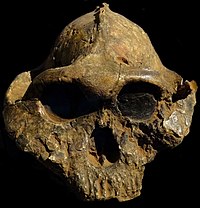Paranthropus boisei
| Paranthropus Boisei Temporal range: , 2.3–1.2 Ma |
|
|---|---|
 |
|
| Photograph of KNM ER 406, a male specimen. | |
| Scientific classification | |
| Kingdom: | Animalia |
| Phylum: | Chordata |
| Class: | Mammalia |
| Order: | Primates |
| Family: | Hominidae |
| Genus: | Paranthropus |
| Species: | P. boisei |
| Binomial name | |
|
†Paranthropus boisei (Mary Leakey, 1959) |
|
| Synonyms | |
|
|
Paranthropus boisei or Australopithecus boisei was an early hominin, described as the largest of the Paranthropus genus (robust australopithecines). It lived in Eastern Africa during the epoch from about 2.4 until about 1.4 million years ago.
First discovered by anthropologist Mary Leakey on July 17, 1959, at Olduvai Gorge, Tanzania, the well-preserved cranium (nicknamed "Nutcracker Man") was dated to 1.75 million years ago and had characteristics distinctive of the robust australopithecines. Mary and her husband Louis Leakey classified the find as Zinjanthropus boisei: "Zinj" for the medieval East African region of Zanj, "anthropus" (Gr. ανθρωπος, anthropos) for "human being", and "boisei" for Charles Watson Boise, the anthropologist team’s benefactor.
Paranthropus boisei (as the species was eventually categorized) proved to be a treasure, especially when the anthropologists' son Richard Leakey suggested it was the first hominin species to use stone tools. Bernard Wood of the University of Liverpool, England, posits that tools discovered in Ethiopia and dated to 2.5 million years ago could have been made by Paranthropus boisei. A well-preserved jaw, known as the Peninj Mandible, was found by Richard's colleague Kamoya Kimeu in 1964 in Peninj, Tanzania. Another skull, specimen KNM ER 406, was unearthed in 1969 by Richard at Koobi Fora near Lake Turkana, in Kenya.
The brain volume is quite small, about 500 to 550 cm³, not much larger than Australopithecus afarensis and Australopithecus africanus or modern-day chimpanzees. In P. boisei the foramen magnum is much shorter than in P. robustus. In, addition, the cranial variation of P. boisei is remarkably high. The adult males were larger on average than females (sexual dimorphism), as was the case in virtually all australopithecine species. Males weighed some 49 kg (108 lb) and stood about 1.37 m (4 ft 6 in) tall, while females weighed about 34 kg (75 lb) and were 1.24 m (4 ft 1 in) tall.
...
Wikipedia
